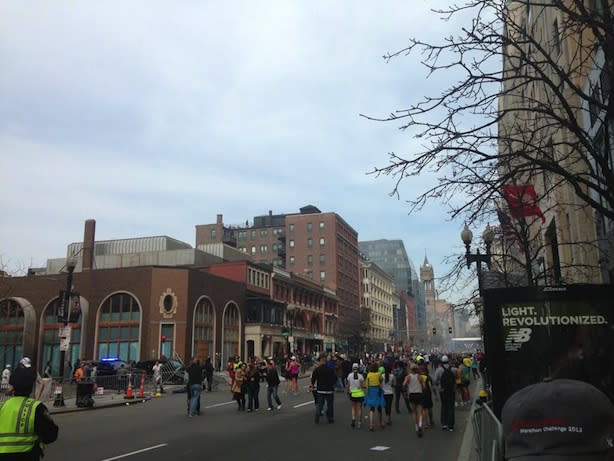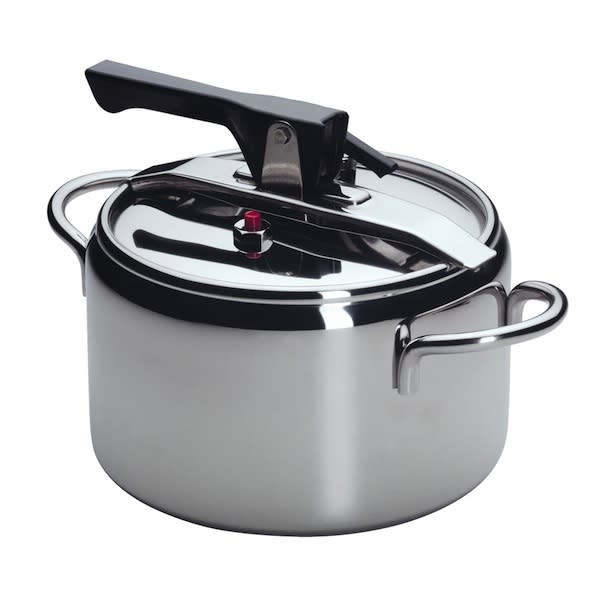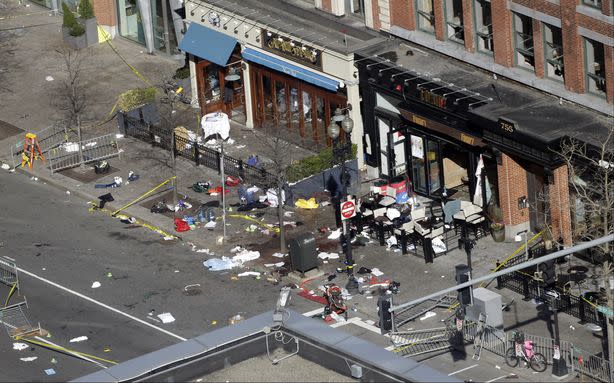Pressure Cookers, Nails, BBs, and Bags: What We Know About the Boston Bombs
Perhaps the only early clues to emerge on an eerily quiet second day of the Boston Marathon bombing investigation — from the ATF and the FBI and the Boston police, from anonymous law enforcement officials and doctors pulling ball bearings out of victims' limbs — concern the Boston bombs themselves. Even as Gene Marquez of the Bureau of Alcohol, Tobacco, and Firearms said at a morning press briefing that 30 forensic specialists would spend the next several says processing the crime scene, a combination of media reports and forensics expertise combine to give us a rough picture of what everyone wants to know besides how everyone's doing and who did this: How did the bombs go off?
RELATED: The Stories Behind the Most Indelible Images of the Boston Bombing
The two explosive devices were placed approximately a block apart on Boylston Street in downtown Boston and detonated within 13 seconds of each other. Multiple videos captured the bombs as they went off, but many details of their manufacture and placement, like much of this story, remain publicly elusive: what they contained, how they were activated, where they were hidden, and how many were found in and around Copley Square. A bunch of reports concerning each detail cropped up throughout Monday only to be disproven hours later, only adding to the ongoing confusion. Here's a guide to what we know so far.
RELATED: 4,300 Runners Skipped the Boston Marathon
There were only two bombs
In the hours following the explosions, an array of outlets — including the Associated Press, The Wall Street Journal, and The New York Times — quoted anonymous law enforcement officials who said that police had discovered three and even five additional, unexploded devices around the Boston area. The reports emerged around the same time that, as first reported by The Boston Globe, a bomb squad arranged and detonated a "controlled explosion" on Boylston Street, just east of the first two explosions, in order to destroy a cache of "suspicious packages" that officials had come across. A similar scene played out in the Boston suburb of Newton, where a bomb squad used a robot to investigate a suspicious object that turned to be a circuit board. Monday night, the Journal quoted law enforcement officials as saying there had been five devices, then updated its report to clarify that "investigators now doubt the devices were bombs." But during Tuesday morning's press conference, Massachusetts Governor Deval Patrick announced that law enforcement agents had not in fact discovered any other bombs. "It's important to clarify that two and only two explosive devices were found yesterday. Other parcels have been examined ... but there were no unexploded bombs," he told reporters.
RELATED: After a Bombing in Boston, All Quiet In Washington
The bombs may have been based in pressure cookers
A representative of Boston Children's Hospital said at Tuesday afternoon press briefing that children being treated for injuries "had BBs and nails embedded in their bodies," which were presumably packed into or around the bombs in order to maximize damage. (Massachusetts Congressman Stephen Lynch, reiterating what doctors at multiple hospitals had reported at briefings of their own Monday night, told Yahoo News that many victims were struck by what appeared to be metal ball bearings.) The exact design of the bombs, of course, remains unclear. Citing an unnamed source familiar with the investigation, the Associated Press reported on Tuesday morning that investigators, upon recovering pieces of the exploded bombs, determined that they were made of 6-liter pressure cookers, which were packed with ball bearings and metal nails and stuffed into "black duffel bags." (CNN described them as "backpacks".) On Tuesday afternoon this information was reported by multiple outlets speaking to sources with knowledge of the Boston investigation.
RELATED: What Happened at Boston's JFK Library?
This is what your average pressure cooker looks like:
RELATED: Explosions at Boston Marathon Kill 3 — Now, a 'Potential Terrorist Investigation'
It's a metal container used to quickly cook food using trapped steam. (The cooker's contents are heated using a stove or a built-in heating element, in the case of electric models.) You can buy one pretty much anywhere. For these reasons it makes an attractive container (to terrible, violent people) for holding, transporting, and detonating explosive materials. "Terrorists use pressure cookers as IED containers for 2 main reasons," Israeli journalist Elizabeth Tsurkov explained via Twitter on Tuesday afternoon. "The pressure cooker increases the pressure of the explosion gasses [and] and because the metal casings becomes deadly fragmentation upon detonation."
Indeed, there's a long history of terrorists employing pressure cookers abroad. On Tuesday morning Time's Michael Crowley surfaced a 2004 memo issued by the Department of Homeland Security, cataloging episodes in which Afghan terrorists used pressure cookers to fabricate explosive devices and detonated them in several countries throughout the 2000s. (Such contraptions are especially prevalent in contested regions of Pakistan.)
American soil is no stranger to these contraptions, either. The foiled terrorist plot to detonate a bomb in Times Square on May 1, 2010, involved a pressure cooker.
Indeed, nobody in law enforcement or government is making any public connections to any groups or places right now. A Saudi man reported to be a "person of interest" has been cleared as a suspect. As President Obama said at the White House Tuesday: "What we don't yet know, however, is who carried out this attack, or why; whether it was planned and executed by a terrorist organization, foreign or domestic, or was the act of a malevolent individual. That's what we don't yet know. And clearly, we're at the beginning of our investigation."
In a post expanding on the memo, Time's Crowley noted the ease of creating such an explosive device. "The ability to make these bombs is hardly unique to al Qaeda and its sympathizers. Details on how to make a pressure cooker bomb can also be found on websites associated with anarchy and other forms of non-religious radicalism," he said, before linking to such a website.
Other evidence suggests that the bombs were made with readily-available chemicals. New Scientist asked a bomb expert to study the footage of the explosion for clues of the bombs origin. Here's what the expert concluded: "The Boston bombs ... produced an orange flash followed by white smoke. This suggests the bombs contained neither TNT nor RDX, which produce black smoke, but could have been a home-made chlorate-based device."
It's unclear how the bombs detonated
In the same report detailing how the bombs were built, the Associated Press notes, "law enforcement officials have some of the bomb components but [do] not yet know what was used to set off the explosives." In that vacuum of knowledge a number of rumors have appeared: 1) the bombs used a timer; 2) the bombs were activated remotely; 3) cell phone service was shut down in downtown Boston to avert other remotely-activated bombs; and 4) a mysterious roof-top figure captured in a single photo has something to do with setting off the bomb.
Rumor No. 1 appears to be the strongest. After speaking to an official close to the investigation, CNN knocked down rumors (discussed below) that the bomb had been detonated using a cell phone-activated trigger, and reported that investigators in Boston think the bombs had timers attached to them instead. And, within minutes of CNN's report, the Globe reported that investigators had turned up a circuit board they believe was used to trigger the explosions; it was reportedly found near a spot where Gov. Patrick had been seated earlier in the day.
Rumor No. 2 is not far-fetched — remotely-activated bombs certainly exist, and are used frequently throughout the world — but remains unconfirmed by officials studying either bomb's remains. But the nature of the explosions, which occurred in quick succession, seems to indicate that they were coordinated in some way. The same expert who spoke to New Scientist said, "My guess is that these were remotely activated bombs because the two devices went off very close to each other, so were probably being controlled in some way." (That doesn't necessarily rule out some kind of electronic or mechanical timer, though, and expert's guesses are far from conclusive right now — or ever.)
Rumor No. 3 is false. Cell phone reception declined in downtown Boston, given the number of calls flooding into and out of its vicinity, but no entity shut off all service in hopes of jamming a signal that would have activated another bomb. On Monday the Associated Press — again quoting an unnamed law enforcement official — reported that "cellphone service had been shut down Monday in the Boston area to prevent any potential remote detonations of explosives" but added, in the next paragraph, that neither Verizon nor Sprint had received or executed such a request, thereby invalidating the entire report. Here's a full report from the cell providers themselves.
Rumor No. 4 is based entirely on this viral photo:
Did you see that? We've circled the mysterious figure below:
The New York Daily News sums up the strength of this rumor quite nicely: "One of the first accounts to point out the mysterious figure was @Fraank_Oceaan, a parody Twitter for singer Frank Ocean. The post has since been retweeted more than 2,200 times."
This story is still developing as investigators continue their search for a perpetrator — and study each bomb's remains. In the meantime, keep up with the latest developments of the Boston Marathon bombings with the Wire's live updates.





